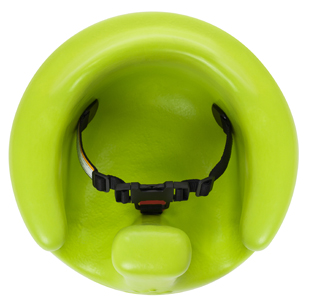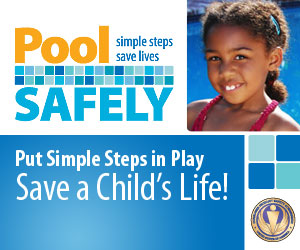OnSafety is the Official Blog Site of the U.S. Consumer Product Safety Commission. Here you'll find the latest safety information as well as important messages that will keep you and your family safe. We hope you'll visit often!
|
By CPSC Blogger on August 29, 2012
Do you put your baby in a Summer Infant Mother’s Touch/Deluxe Baby Bather? Check it immediately to see if it has been recalled. About 2 million of the bathers were sold in the U.S. between September 2004 and November 2011.
If you have one, stop using it immediately until you have installed a free repair kit that includes a locking strap. CPSC and Summer Infant have received seven reports of incidents, including five reports of infants suffering head injuries—including skull fractures—from falls from this product:
 Summer Infant Baby Bather Here’s what happens: When you lift the bath product and baby together, the folding wire frame can suddenly disengage from the side hinge. Your baby can drop out of the bather. Baby bathers manufactured since July 2007 include the warning, “Never lift or carry the bather with infant in it.”
Four children between the ages of 2 weeks and 2 months old fractured their skulls in falls. One of those children required intensive care due to bleeding on the brain. A fifth baby had a bump to the head requiring emergency room treatment.
The recall to repair involves Summer Infant baby bathers with a small, nearly square blue or pink plastic base. Check this recall announcement for specific model information that will tell you whether your baby bather is included in the recall. Products sold since November 2011 are not included in this recall.
For additional information and to order a free repair kit designed to prevent the frame from suddenly folding if the bather is lifted with a baby in it, call Summer Infant at (800) 426-8627 between 8 a.m. and 5 p.m. ET Monday through Friday or visit the firm’s recall page. The repair kit includes a locking strap and instructions.
This address for this post is: http://www.cpsc.gov/onsafety/2012/08/serious-head-injuries-with-falls-from-summer-infant-baby-bathers/
By CPSC Blogger on August 27, 2012
Updated: Sept. 4, 2012
 In late August, CPSC voted to begin rulemaking to address the serious risks posed by hazardous, high-powered magnet sets. You will have 75 days to comment to the agency about the rulemaking. Your comments are due to CPSC by Nov. 19. In late August, CPSC voted to begin rulemaking to address the serious risks posed by hazardous, high-powered magnet sets. You will have 75 days to comment to the agency about the rulemaking. Your comments are due to CPSC by Nov. 19.
CPSC staff briefed the commission about the magnet hazards at an open meeting on Thursday, Aug. 9.
Between 2009 and 2011, our staff estimates that there were 1,700 cases treated in hospital emergency rooms nationwide related to the ingestion of small, high powered magnets. More than 70 percent of these cases involved children between the ages of 4 and 12.
The agency’s staff is proposing a rule that addresses the size and strength of the magnets. Under the proposed rule, magnets that fit in a small parts tester would be required to have a flux index of 50 or less. Many of the high-powered magnets in the sets sold today, by comparison, are many times stronger.
Magnet sets that do not meet the new requirements could not be sold as a manipulative or a desk toy.
CPSC has published a notice of proposed rulemaking in the Federal Register. (FR). Now that the proposed rulemaking has published, your opportunity to comment begins. Here’s where you can share your comments about this proposed rule. Your comments must be submitted by 11:59 p.m. ET on Nov. 19.
Rulemaking comments are submitted through the government website Regulations.gov. We will publicize the Federal Register notice and the link to comment on our website, our @OnSafety Twitter account, and in this blog.
We continue to encourage everyone to read the information on our magnet information page. Watch the video. Keep these magnets away from all children and out of homes with children. For us, it’s about keeping kids safe.
This address for this post is: http://www.cpsc.gov/onsafety/2012/08/magnet-rulemaking-how-you-can-be-involved/
By CPSC Blogger on August 15, 2012
If you’re one of the many parents or caregivers who use a Bumbo Baby Seat, we now have additional information for you beyond our November 2011 warning about infants falling from the seats and suffering serious head injuries.
Bumbo International Trust is recalling about 4 million baby seats. Stop putting your babies in these seats until you get and install a free safety repair kit from Bumbo. The kit includes a restraint belt with a warning label, installation instructions for the belt, safe use instructions, and a new warning sticker.
Without the restraint belt, an infant placed in the Bumbo seat can maneuver out or fall from the seat by arching his/her back, leaning forward or sideways, or rocking.
Here’s what the seat should look like before you use it again:
 Bumbo Baby Seat with Restraint Belt Parents and caregivers: ONLY use the Bumbo seat on the floor. Do not use this product to bring your baby eye level with you, such as on tables, counters, chairs, sofas or any raised surface — even with the belt. Never use the seat on raised surfaces. Don’t use it as a car or bath seat, either.
CPSC and Bumbo are aware of 19 reports of skull fractures from among at least 50 incidents of infants falling from Bumbo seats that were used on high surfaces such as a countertop, chair or table. These all occurred after a 2007 recall of the Bumbo seat to add a warning on the front of the seat that alerts caregivers not to use the seat on an elevated surface. Additional reports of falls and skull fractures were described in the 2007 recall.
In addition, we are aware of 34 injury reports—including two skull fractures—since the recall of babies falling or maneuvering out of Bumbo seats that were used either on the floor or at unknown elevations.
This address for this post is: http://www.cpsc.gov/onsafety/2012/08/bumbo-update-baby-seats-recalled-get-restraint-belt/
By CPSC Blogger on August 8, 2012
Small high-powered magnets swallowed by children are like a bullet hole in the body with no entry or exit wound, say doctors who have surgically removed magnets from children’s bodies.
When these individual magnets are ingested, they connect inside the body. The bonds are so strong that the magnets clamp digestive organ tissue together and tear holes at the contact points. The resulting injuries are horrific and life-altering. The surgeries to remove the magnets are time consuming and expensive.
High-powered magnets that connect in a child’s body are a serious injury, or even a death, waiting to happen. We are not willing to stand back and wait for these incidents to keep occurring before acting.
Doctors say that time is of the essence when treating these injuries. Yet, the symptoms can be vague—typical of a stomach virus. Unless you KNOW that a child has swallowed magnets, you might think your child has a stomach bug.
A marble, a coin and other small nonmagnetic things can pass through a child’s body. A doctor’s plan when a child swallows something is typically to watch and wait. This approach often works for nonmagnetic products. In the case of high-powered magnets, however, watch and wait can be life-altering. Watch and wait means that the injury has time to worsen.
The American Academy of Pediatrics has alerted pediatricians to the dangers of magnet ingestions. And the North American Society for Pediatric Gastroenterology, Hepatology and Nutrition issued an alert and podcast series for doctors about the “dangers of neodymium magnet ingestion in pediatric patients.” Texas pediatric gastroenterologist Bryan Vartabedian, writes in his blog that emerging data from doctors shows that the number of cases have been under-reported.
We encourage everyone to read the information on our magnet information page. Watch the video. Keep these magnets away from all children and out of homes with children.
This address for this post is: http://www.cpsc.gov/onsafety/2012/08/small-high-powered-magnets-a-very-serious-hazard-to-children/
By CPSC Blogger on July 27, 2012
 In July and early August, millions of American eyes will be on the pool. How will top U.S. swimmers Michael Phelps and Ryan Lochte do in London? In July and early August, millions of American eyes will be on the pool. How will top U.S. swimmers Michael Phelps and Ryan Lochte do in London?
Many Americans, both in the African-American community and elsewhere, are particularly excited about Cullen Jones and Lia Neal. Ebony Magazine calls Jones and Neal “two young Olympians poised to change what they say about African-Americans and swimming.”
Olympic swimmers, and even kids who compete in neighborhood swimming competitions, make the sport look so easy. We hope the Olympics is a conversation starter in your home as the Olympians inspire your children to learn how to swim. Do your best to teach your children not to fear the water. Pass on safety and fun at the same time. (See NBC’s Rock Center story on the importance of swimming.)
At home, we, as a nation, need more eyes on our much less experienced swimmers. All Olympic swimmers, from Jones to Phelps, from Neal to Lochte, have one thing in common with every child. At one time in their lives they didn’t know how to swim.
According to news reports, when Jones was 5 years old, he nearly drowned at a water park. (Source: Good Morning America/ABC) That’s when Jones started swimming lessons.
Lessons. They are a simple step that saves lives. They will help teach your child a life-saving skill: How to be safe around water. Use the Olympics as a conversation starter with your child about starting swimming lessons.
Between Memorial Day and July 17, at least 90 children younger than 15 were reported by media to have drowned in swimming pools. Another 106 children were sent to emergency rooms for nearly drowning. That’s about 2 children who died each day during that period.
Drowning is the leading cause of injury death for children ages 1 to 4. African-American children and young adults ages 5 to 19 die from drowning 6 times more often than their white peers, according to the Centers for Disease Control and Prevention. And a USA Swimming/University of Memphis survey says that 70 percent of African-American and 60 percent of Hispanic/Latino children can’t swim.
Simple steps save lives.
- Stay within arm’s reach of children and non-swimmers at all times in and around the pool.
- Keep eyes on young children.
- Fence your pool with self-closing or self-latching gates.
- Assign a water watcher.
- Learn CPR.
- If a child is missing, check the pool first.
This week, pools and waterparks around the country are holding Pool Safely Days to help spread this message of safety. You can help, too. Post these buttons, badges and widget on your blogs, Facebook pages and websites. Put Pool Safely steps into play at your home. Teach them to your children and your neighbors.
Save a child’s life. Earn a gold medal in swimming safety.
This address for this post is: http://www.cpsc.gov/onsafety/2012/07/all-eyes-on-the-pool/
|
|











